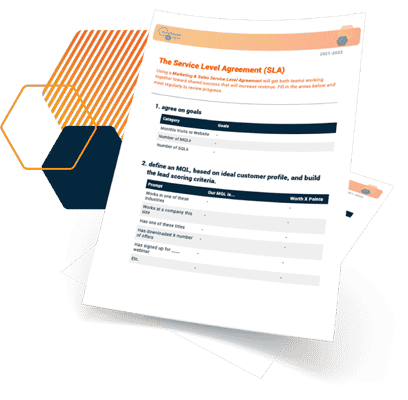
Tell me if you’ve heard this before: Your marketing team is fist-bumping all day long because they sent 531 new leads to Sales this month—a new record! Meanwhile, your sales team is shaking their fists all day long because Marketing sent them 531 worthless sales leads this month—a new low.
If that sounds familiar, you’re not alone. On average, only 25% of leads are legitimate and should be sent to the sales team.
The problem often lies in the fact that Sales and Marketing are on different pages and have very different ideas of what a qualified lead looks like. We see this problem a lot, and we use a simple and amazingly effective tool that can start improving the quality of your sales leads right away.
Want to see better-qualified leads? Create a service level agreement (SLA) for your sales and marketing teams.
Crafting a sales and marketing SLA means the sales and marketing teams need to sit down and work together to arrive at an agreement. This isn’t always easy, but the payoff can be huge. At Hivehouse Digital, we call it a Smarketing Promise.
Here’s what our Smarketing Promise looks like.
The Smarketing Promise: Your Sales & Marketing SLA
The Smarketing Promise is a simple, one- or two-page agreement between your sales and marketing teams that defines your goals for the quarter, establishes exactly what a qualified lead looks like, and explains how to handle qualified leads.
There are six sections to the Smarketing Promise:
Goals
First, you’ll need to identify your sales and marketing goals for the quarter. For example:
- Monthly visits to website
- Number of Marketing Qualified Leads (MQLs)
- Number of Sales Qualified Leads (SQLs)
These are shared goals that are relevant to the Sales & Marketing SLA. You’ll probably have other goals that are specific to your sales and marketing teams that don’t belong here.
MQL and lead scoring criteria
This is the marketing team’s promise to Sales that they’ll provide high-quality leads.
To help Marketing, Sales should communicate the criteria that they’re looking for in a qualified lead. The criteria should be based on your ideal customer and may include considerations such as:
- Industry
- Company size and revenue
- Job title
- Persona information
- Actions taken (downloaded content, attended an event or webinar, subscribed to the newsletter, etc.)
Assign a point value for each criterion that defines an MQL, based on the significance of the action a lead takes. So, filling out a TOFU form might be worth 10 points while requesting a demo might be worth 50 points.
Once a lead reaches a certain point value (which you determine), they’re designated as a qualified lead. At Hivehouse Digital, we use HubSpot’s custom lead scoring features.
With lead scoring, you don’t have to wait for each lead to raise their hand when they’re ready to be contacted. You can see for yourself when they’re ready even if they don’t fill out a contact form.
Quarterly MQL goal
Set an MQL goal each quarter and track your metrics so you have an objective way to tell exactly how well you’re actually doing. Keep the following in mind:
- Sales revenue goals
- Past marketing numbers
- Size of the sales team
- Size of the marketing team
Be sure to review and update your goals together each quarter.
Lead handoff workflow
In this section, you’re capturing exactly how to do the lead handoffs. Define when a lead gets passed from Marketing to Sales, and spell out the roles and responsibilities for each team. For example: When a contact has reached a score of 75, an email will be sent to the sales team, and a task is automatically assigned for them to either accept the MQL as an SQL or take the necessary steps to disqualify it.
Sales engagement flow and agreement
Marketing has promised to provide the right kind of lead at the right time in the right way. Now the sales team promises to take specific action on each SQL. You should identify a specific action and a timeframe for taking that action. For example: Sales will contact the MQL within 2 hours by phone or email.
MQL-to-SQL performance
Be sure to track your effectiveness in converting MQLs to SQLs. Each quarter, review these metrics:
- How many MQLs converted to SQLs
- How many MQLs became customers
- Which campaigns or offers drove the most leads to customers
There’s no better way to align your sales and marketing teams and improve the quality of your leads than creating a Smarketing Promise. In fact, nearly half of companies with defined lead management processes have sales teams that follow up on more than 75% of the MQLs.
Get the latest news
Blog Topics
- Analytics
- Branding & Identity
- Budget
- Construction
- Content Marketing
- Conversion Rate Optimization
- Email Marketing
- HubSpot
- Inbound Marketing
- Lead Generation
- Marketing Strategy
- News/Events
- Paid Search & PPC
- Recruiting
- Sales & Marketing
- Sales Enablement
- Search Engine Marketing
- Search Engine Optimization
- Social Media
- Thought Leadership
- Uncategorized
- Usability
- Video Marketing
- Web Hosting
- Website Design
